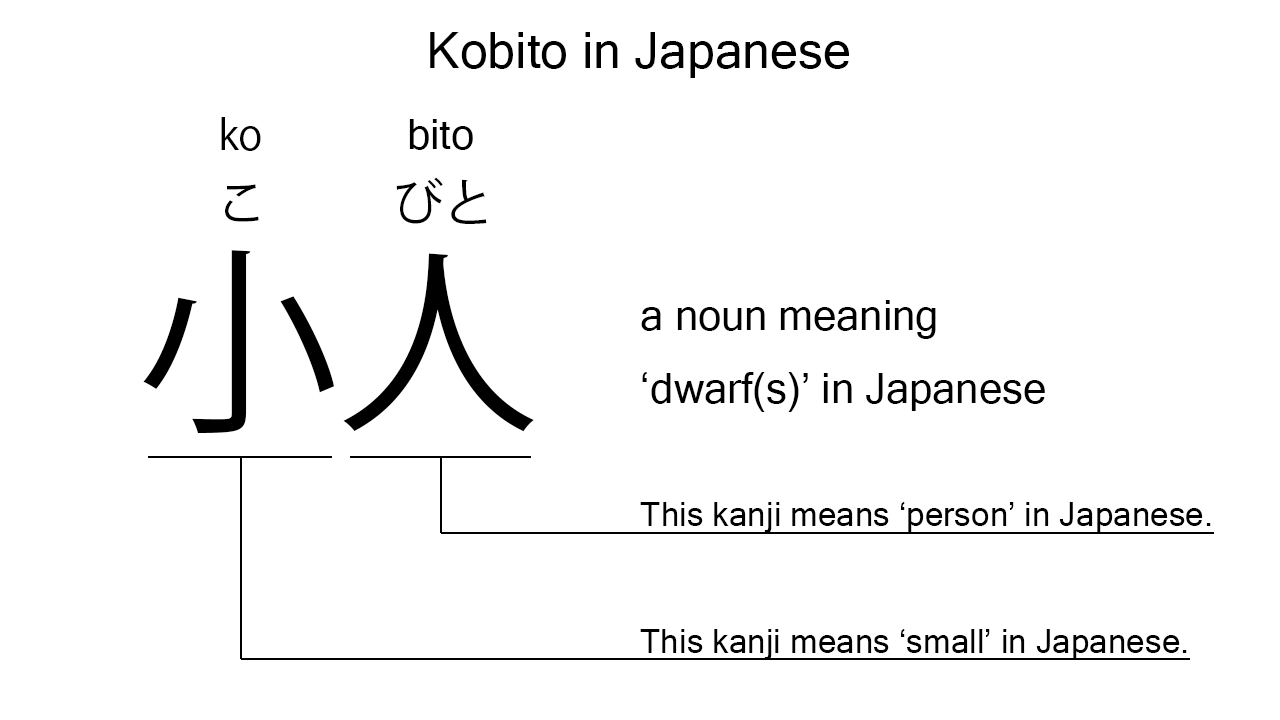What does “kobito” mean in Japanese?
Native speakers say “kobito” often to mean ‘dwarf’ in Japanese. Perhaps, some Japanese learners know this word as it is sometimes used in Japanese movies, video games, novels, manga, anime, and the like. In this blog post, however, I will explain this word in detail based on its kanji expression. And also, I will explain how to use it through example sentences. My explanations would help Japanese learners understand “kobito” more clearly. Then, let’s get started!
Contents
Definition and meaning of “kobito”
Let me start with the definition and meaning of “kobito”.
- kobito – 小人 (こびと) : a noun meaning ‘dwarf’ in Japanese. This can also work as plural. Learn more about Japanese plural.
The definition and meaning are simple and clear. To understand this noun more clearly, however, let me explain its kanji characters in detail, one by one.
Kobito in kanji
The kanji expression of “kobito” consists of the following two kanji characters:
- 小 : a kanji character used to mean ‘small’ in Japanese.
- 人 : a kanji character used to mean ‘person’ in Japanese.
These two kanji characters tell us that the formed noun literally means a ‘small person’ in Japanese. This literal interpretation is not completely in line with the actual meaning, but still understandable, I think. Dwarfs are often small and human-shaped creatures.

When we meet new kanji expressions, we should check their kanji characters in detail to understand their meanings clearly and deeply. In many cases, kanji characters tell us a lot about the meanings of the expressions they form. Actually, here, we could get the better understanding of “kobito” through the detailed kanji check above.
So far, I’ve explained the definition and meaning of “kobito” together with its kanji characters. Then, let me explain how to use it through the example sentences below.
Example #1: how to say “dwarf” in Japanese
watashi tachi wa mori de kobito wo mi ta – 私達は森で小人を見た (わたしたちはもりでこびとをみた)
We saw a dwarf in the forest.
Below are the new words used in the example sentence.
- watashi – 私 (わたし) : a pronoun meaning ‘I’ in Japanese.
- tachi – 達 (たち) : a suffix used after a noun or pronoun to make its plural form. In the example, this is used after “watashi” to make its plural form, “watashi tachi”, which means ‘we’ in Japanese.
- wa – は : a binding particle working as a case marker or topic marker. In the example, this works after “watashi tachi” to make the subject in the sentence.
- mori – 森 (もり) : a noun meaning ‘forest’ in Japanese.
- de – で : a case particle used to say where someone does something. In the example, this is used after “mori” to say where the speakers saw the dwarf.
- wo – を : a case particle used to make the object word in a sentence. In the example, this is used after “kobito” to make the object in the sentence.
- mi – 見 (み) : one conjugation of the verb, “miru“, which means ‘to see’ or such in Japanese. In the example, it has been conjugated for the better connection with its following word.
- ta – た : an auxiliary verb used after a verb, adjective, or auxiliary verb to make its past tense form. In the example, this is used after “mi” to make its past tense form, “mi ta”.
This is a typical usage of “kobito”. In this example, it works together with the case particle, “wo”, to become the object in the sentence.
Example #2: another usage of “kobito”
kobito wa totemo chiisakat ta – 小人はとても小さかった (こびとはとてもちいさかった)
The dwarf was very small.
Below are the new words used in the example sentence.
- totemo – とても : an adverb of degree meaning ‘very’, ‘much’, ‘so’, or such in Japanese. In the example, this works in front of “chiisakat ta” to emphasize its meaning.
- chiisakat – 小さかっ (ちいさかっ) : one conjugation of the i-adjective, “chiisai“, which means ‘small’ in Japanese. In the example, it has been conjugated for the better connection with its following word.
This is another typical usage of “kobito”. In this example, it works together with the binding particle, “wa”, to become the subject in the sentence. When we want to refer to dwarfs in Japanese, anyway, this noun is always a good option.
Summary
In this blog post, I’ve explained the definition and meaning of “kobito” in detail based on its kanji expression. And also, I’ve explained how to use it through the example sentences. Let me summarize them as follows.
- kobito – 小人 (こびと) : a noun meaning ‘dwarf’ in Japanese. This can also work as plural. These two kanji characters literally mean a ‘small person’ in Japanese. This literal interpretation is not completely in line with the actual meaning, but still understandable, I think. Dwarfs are often small and human-shaped creatures.
Hope my explanations are understandable and helpful for Japanese learners.